TAE40116 Certificate IV Training and Assessment Workbook 1
VerifiedAdded on 2022/08/30
|129
|18314
|32
Homework Assignment
AI Summary
This document presents Assessment Workbook 1 for the TAE40116 Certificate IV in Training and Assessment, focusing on the Design Cluster. It covers key aspects of competency-based assessment, including the definition of competency, the principles of assessing nationally recognized training, and the dimensions of competency. The workbook includes knowledge assessments and practical assessments related to units like TAEDES401 (Design and develop learning programs), TAEDES402 (Use training packages and accredited courses to meet client needs), and TAELLN411 (Address adult language, literacy and numeracy skills). It features case studies and projects involving training needs analysis, learning program design and development, and evaluation, providing a comprehensive guide for learners in the field of training and assessment. The workbook also includes essential resources, instructions, and checklists to facilitate the assessment process.
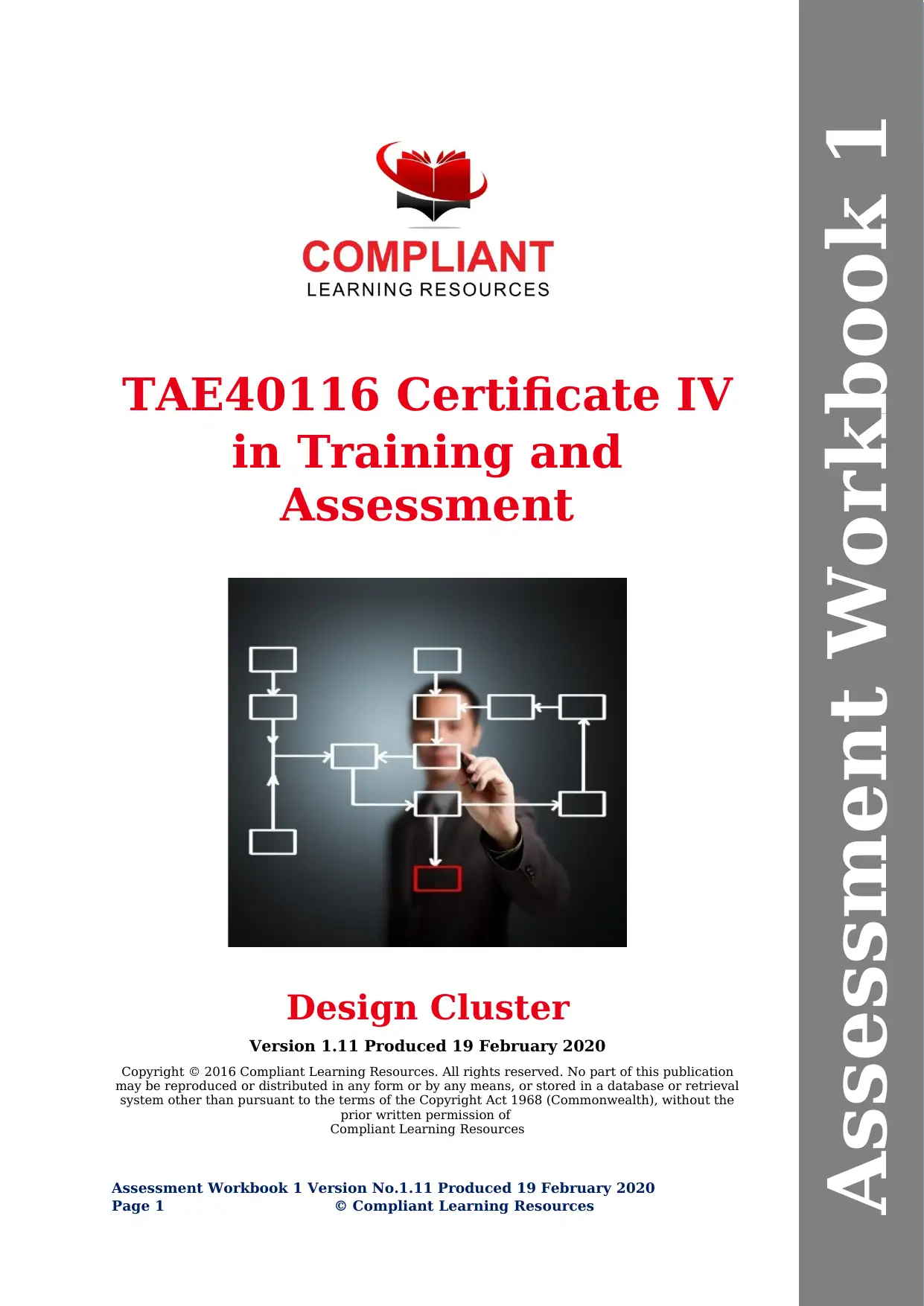
TAE40116 Certificate IV
in Training and
Assessment
Design Cluster
Version 1.11 Produced 19 February 2020
Copyright © 2016 Compliant Learning Resources. All rights reserved. No part of this publication
may be reproduced or distributed in any form or by any means, or stored in a database or retrieval
system other than pursuant to the terms of the Copyright Act 1968 (Commonwealth), without the
prior written permission of
Compliant Learning Resources
Assessment Workbook 1 Version No.1.11 Produced 19 February 2020
Page 1 © Compliant Learning Resources
Assessment Workbook 1
in Training and
Assessment
Design Cluster
Version 1.11 Produced 19 February 2020
Copyright © 2016 Compliant Learning Resources. All rights reserved. No part of this publication
may be reproduced or distributed in any form or by any means, or stored in a database or retrieval
system other than pursuant to the terms of the Copyright Act 1968 (Commonwealth), without the
prior written permission of
Compliant Learning Resources
Assessment Workbook 1 Version No.1.11 Produced 19 February 2020
Page 1 © Compliant Learning Resources
Assessment Workbook 1
Paraphrase This Document
Need a fresh take? Get an instant paraphrase of this document with our AI Paraphraser
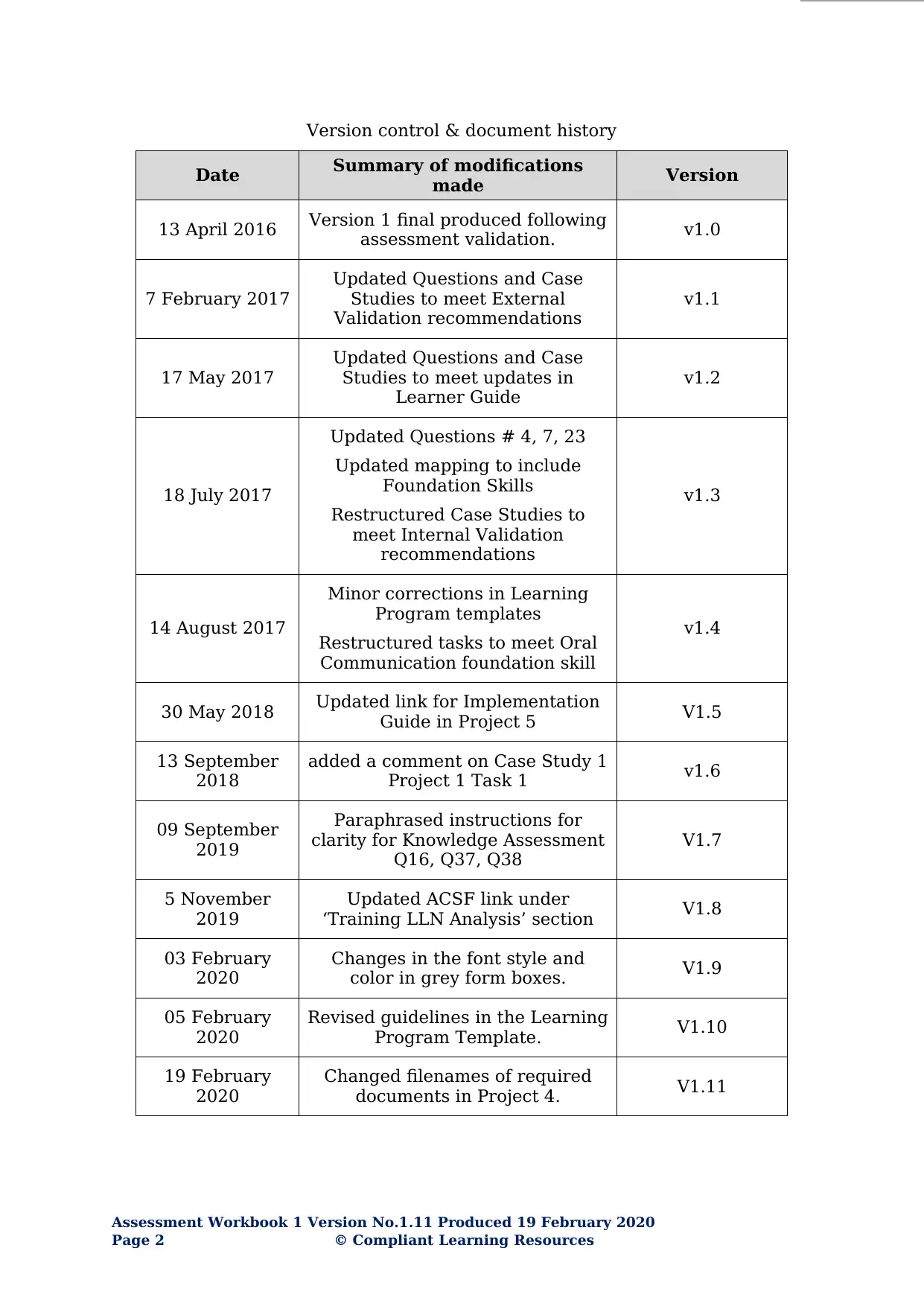
Version control & document history
Date Summary of modifications
made Version
13 April 2016 Version 1 final produced following
assessment validation. v1.0
7 February 2017
Updated Questions and Case
Studies to meet External
Validation recommendations
v1.1
17 May 2017
Updated Questions and Case
Studies to meet updates in
Learner Guide
v1.2
18 July 2017
Updated Questions # 4, 7, 23
Updated mapping to include
Foundation Skills
Restructured Case Studies to
meet Internal Validation
recommendations
v1.3
14 August 2017
Minor corrections in Learning
Program templates
Restructured tasks to meet Oral
Communication foundation skill
v1.4
30 May 2018 Updated link for Implementation
Guide in Project 5 V1.5
13 September
2018
added a comment on Case Study 1
Project 1 Task 1 v1.6
09 September
2019
Paraphrased instructions for
clarity for Knowledge Assessment
Q16, Q37, Q38
V1.7
5 November
2019
Updated ACSF link under
‘Training LLN Analysis’ section V1.8
03 February
2020
Changes in the font style and
color in grey form boxes. V1.9
05 February
2020
Revised guidelines in the Learning
Program Template. V1.10
19 February
2020
Changed filenames of required
documents in Project 4. V1.11
Assessment Workbook 1 Version No.1.11 Produced 19 February 2020
Page 2 © Compliant Learning Resources
Date Summary of modifications
made Version
13 April 2016 Version 1 final produced following
assessment validation. v1.0
7 February 2017
Updated Questions and Case
Studies to meet External
Validation recommendations
v1.1
17 May 2017
Updated Questions and Case
Studies to meet updates in
Learner Guide
v1.2
18 July 2017
Updated Questions # 4, 7, 23
Updated mapping to include
Foundation Skills
Restructured Case Studies to
meet Internal Validation
recommendations
v1.3
14 August 2017
Minor corrections in Learning
Program templates
Restructured tasks to meet Oral
Communication foundation skill
v1.4
30 May 2018 Updated link for Implementation
Guide in Project 5 V1.5
13 September
2018
added a comment on Case Study 1
Project 1 Task 1 v1.6
09 September
2019
Paraphrased instructions for
clarity for Knowledge Assessment
Q16, Q37, Q38
V1.7
5 November
2019
Updated ACSF link under
‘Training LLN Analysis’ section V1.8
03 February
2020
Changes in the font style and
color in grey form boxes. V1.9
05 February
2020
Revised guidelines in the Learning
Program Template. V1.10
19 February
2020
Changed filenames of required
documents in Project 4. V1.11
Assessment Workbook 1 Version No.1.11 Produced 19 February 2020
Page 2 © Compliant Learning Resources
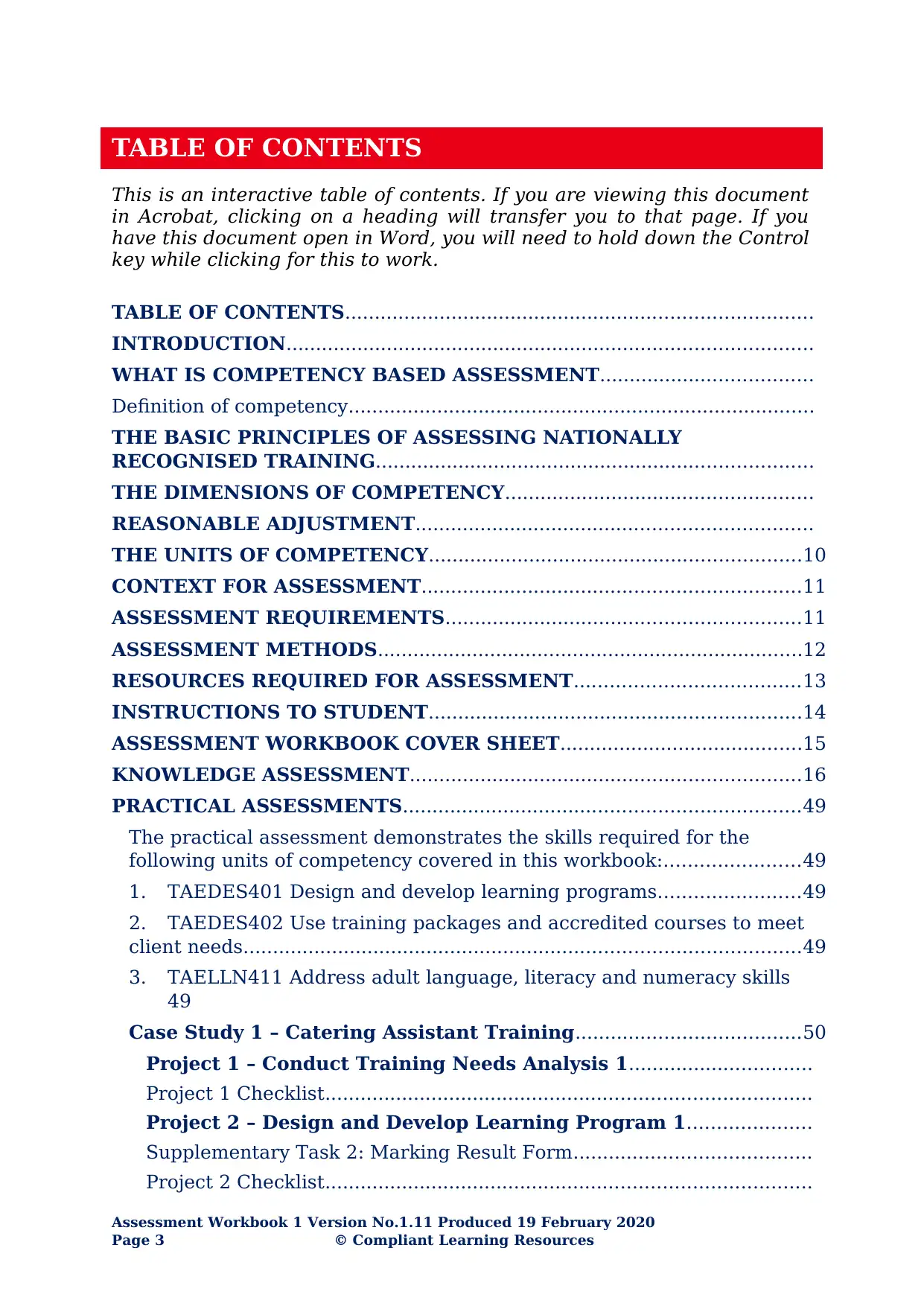
TABLE OF CONTENTS
This is an interactive table of contents. If you are viewing this document
in Acrobat, clicking on a heading will transfer you to that page. If you
have this document open in Word, you will need to hold down the Control
key while clicking for this to work.
TABLE OF CONTENTS...............................................................................
INTRODUCTION.........................................................................................
WHAT IS COMPETENCY BASED ASSESSMENT....................................
Definition of competency...............................................................................
THE BASIC PRINCIPLES OF ASSESSING NATIONALLY
RECOGNISED TRAINING..........................................................................
THE DIMENSIONS OF COMPETENCY....................................................
REASONABLE ADJUSTMENT...................................................................
THE UNITS OF COMPETENCY...............................................................10
CONTEXT FOR ASSESSMENT................................................................11
ASSESSMENT REQUIREMENTS............................................................11
ASSESSMENT METHODS........................................................................12
RESOURCES REQUIRED FOR ASSESSMENT......................................13
INSTRUCTIONS TO STUDENT...............................................................14
ASSESSMENT WORKBOOK COVER SHEET.........................................15
KNOWLEDGE ASSESSMENT..................................................................16
PRACTICAL ASSESSMENTS...................................................................49
The practical assessment demonstrates the skills required for the
following units of competency covered in this workbook:.......................49
1. TAEDES401 Design and develop learning programs........................49
2. TAEDES402 Use training packages and accredited courses to meet
client needs..............................................................................................49
3. TAELLN411 Address adult language, literacy and numeracy skills
49
Case Study 1 – Catering Assistant Training......................................50
Project 1 – Conduct Training Needs Analysis 1...............................
Project 1 Checklist..................................................................................
Project 2 – Design and Develop Learning Program 1.....................
Supplementary Task 2: Marking Result Form........................................
Project 2 Checklist..................................................................................
Assessment Workbook 1 Version No.1.11 Produced 19 February 2020
Page 3 © Compliant Learning Resources
This is an interactive table of contents. If you are viewing this document
in Acrobat, clicking on a heading will transfer you to that page. If you
have this document open in Word, you will need to hold down the Control
key while clicking for this to work.
TABLE OF CONTENTS...............................................................................
INTRODUCTION.........................................................................................
WHAT IS COMPETENCY BASED ASSESSMENT....................................
Definition of competency...............................................................................
THE BASIC PRINCIPLES OF ASSESSING NATIONALLY
RECOGNISED TRAINING..........................................................................
THE DIMENSIONS OF COMPETENCY....................................................
REASONABLE ADJUSTMENT...................................................................
THE UNITS OF COMPETENCY...............................................................10
CONTEXT FOR ASSESSMENT................................................................11
ASSESSMENT REQUIREMENTS............................................................11
ASSESSMENT METHODS........................................................................12
RESOURCES REQUIRED FOR ASSESSMENT......................................13
INSTRUCTIONS TO STUDENT...............................................................14
ASSESSMENT WORKBOOK COVER SHEET.........................................15
KNOWLEDGE ASSESSMENT..................................................................16
PRACTICAL ASSESSMENTS...................................................................49
The practical assessment demonstrates the skills required for the
following units of competency covered in this workbook:.......................49
1. TAEDES401 Design and develop learning programs........................49
2. TAEDES402 Use training packages and accredited courses to meet
client needs..............................................................................................49
3. TAELLN411 Address adult language, literacy and numeracy skills
49
Case Study 1 – Catering Assistant Training......................................50
Project 1 – Conduct Training Needs Analysis 1...............................
Project 1 Checklist..................................................................................
Project 2 – Design and Develop Learning Program 1.....................
Supplementary Task 2: Marking Result Form........................................
Project 2 Checklist..................................................................................
Assessment Workbook 1 Version No.1.11 Produced 19 February 2020
Page 3 © Compliant Learning Resources
⊘ This is a preview!⊘
Do you want full access?
Subscribe today to unlock all pages.

Trusted by 1+ million students worldwide
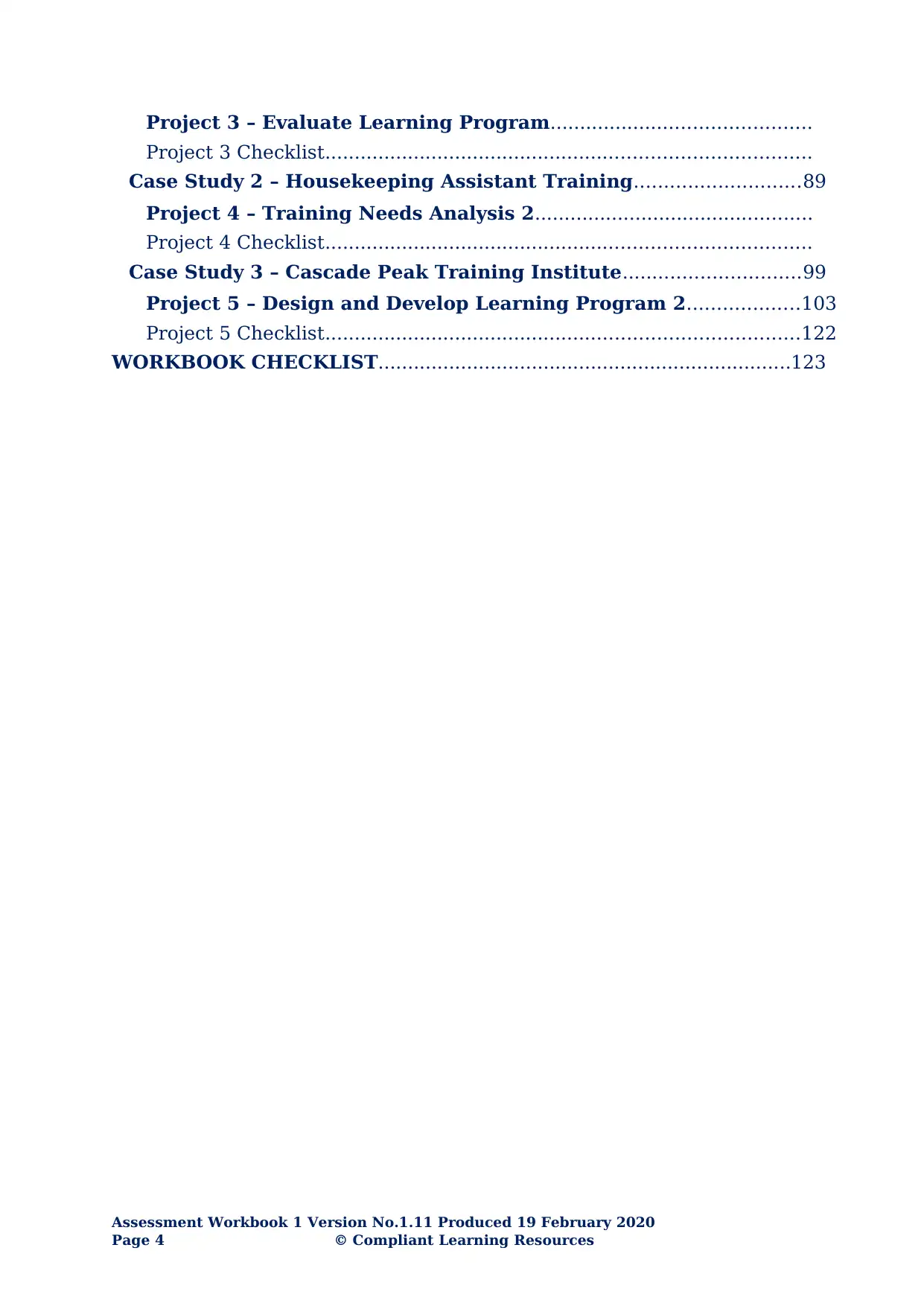
Project 3 – Evaluate Learning Program............................................
Project 3 Checklist..................................................................................
Case Study 2 – Housekeeping Assistant Training............................89
Project 4 – Training Needs Analysis 2...............................................
Project 4 Checklist..................................................................................
Case Study 3 – Cascade Peak Training Institute..............................99
Project 5 – Design and Develop Learning Program 2...................103
Project 5 Checklist................................................................................122
WORKBOOK CHECKLIST......................................................................123
Assessment Workbook 1 Version No.1.11 Produced 19 February 2020
Page 4 © Compliant Learning Resources
Project 3 Checklist..................................................................................
Case Study 2 – Housekeeping Assistant Training............................89
Project 4 – Training Needs Analysis 2...............................................
Project 4 Checklist..................................................................................
Case Study 3 – Cascade Peak Training Institute..............................99
Project 5 – Design and Develop Learning Program 2...................103
Project 5 Checklist................................................................................122
WORKBOOK CHECKLIST......................................................................123
Assessment Workbook 1 Version No.1.11 Produced 19 February 2020
Page 4 © Compliant Learning Resources
Paraphrase This Document
Need a fresh take? Get an instant paraphrase of this document with our AI Paraphraser
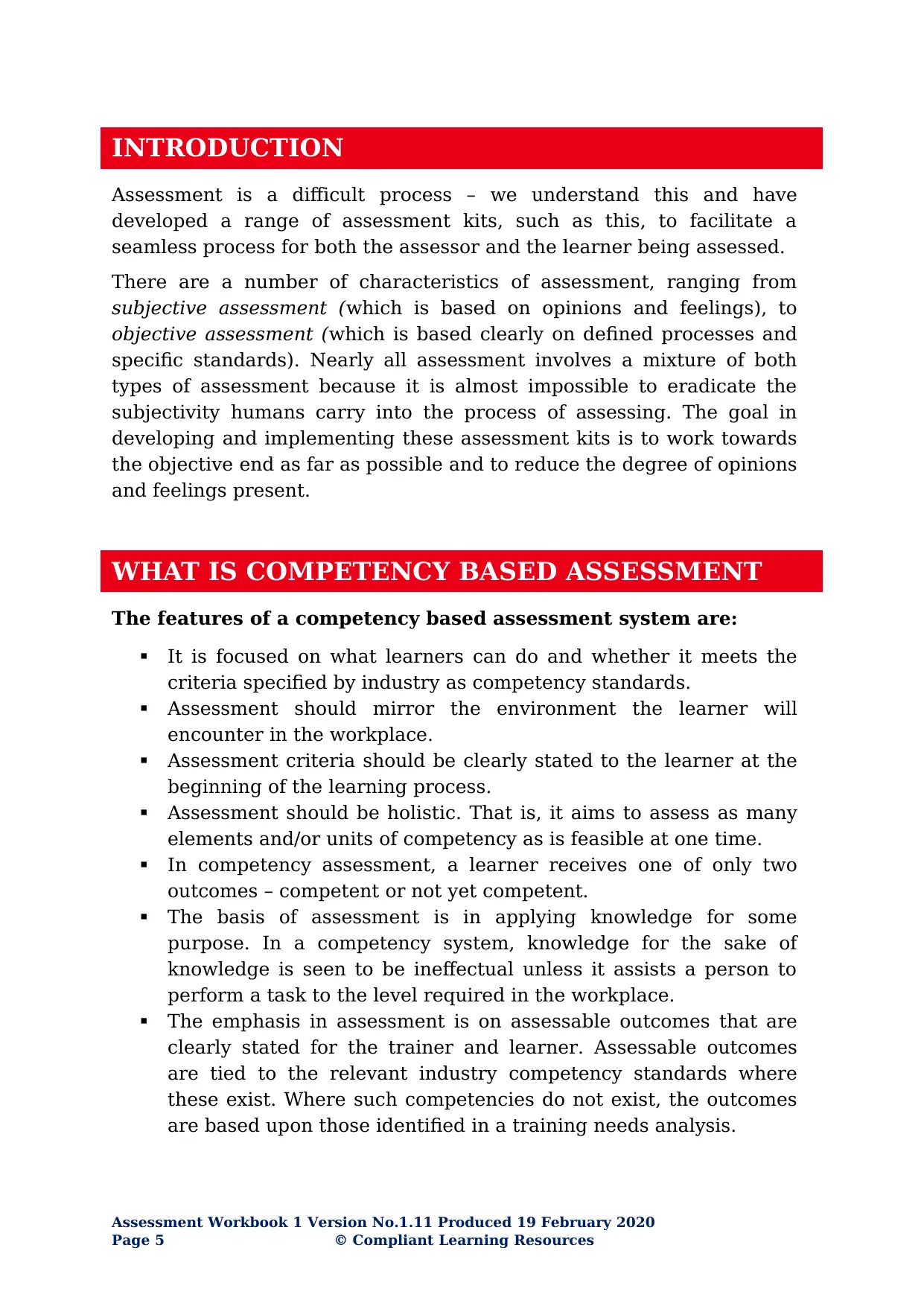
INTRODUCTION
Assessment is a difficult process – we understand this and have
developed a range of assessment kits, such as this, to facilitate a
seamless process for both the assessor and the learner being assessed.
There are a number of characteristics of assessment, ranging from
subjective assessment (which is based on opinions and feelings), to
objective assessment (which is based clearly on defined processes and
specific standards). Nearly all assessment involves a mixture of both
types of assessment because it is almost impossible to eradicate the
subjectivity humans carry into the process of assessing. The goal in
developing and implementing these assessment kits is to work towards
the objective end as far as possible and to reduce the degree of opinions
and feelings present.
WHAT IS COMPETENCY BASED ASSESSMENT
The features of a competency based assessment system are:
It is focused on what learners can do and whether it meets the
criteria specified by industry as competency standards.
Assessment should mirror the environment the learner will
encounter in the workplace.
Assessment criteria should be clearly stated to the learner at the
beginning of the learning process.
Assessment should be holistic. That is, it aims to assess as many
elements and/or units of competency as is feasible at one time.
In competency assessment, a learner receives one of only two
outcomes – competent or not yet competent.
The basis of assessment is in applying knowledge for some
purpose. In a competency system, knowledge for the sake of
knowledge is seen to be ineffectual unless it assists a person to
perform a task to the level required in the workplace.
The emphasis in assessment is on assessable outcomes that are
clearly stated for the trainer and learner. Assessable outcomes
are tied to the relevant industry competency standards where
these exist. Where such competencies do not exist, the outcomes
are based upon those identified in a training needs analysis.
Assessment Workbook 1 Version No.1.11 Produced 19 February 2020
Page 5 © Compliant Learning Resources
Assessment is a difficult process – we understand this and have
developed a range of assessment kits, such as this, to facilitate a
seamless process for both the assessor and the learner being assessed.
There are a number of characteristics of assessment, ranging from
subjective assessment (which is based on opinions and feelings), to
objective assessment (which is based clearly on defined processes and
specific standards). Nearly all assessment involves a mixture of both
types of assessment because it is almost impossible to eradicate the
subjectivity humans carry into the process of assessing. The goal in
developing and implementing these assessment kits is to work towards
the objective end as far as possible and to reduce the degree of opinions
and feelings present.
WHAT IS COMPETENCY BASED ASSESSMENT
The features of a competency based assessment system are:
It is focused on what learners can do and whether it meets the
criteria specified by industry as competency standards.
Assessment should mirror the environment the learner will
encounter in the workplace.
Assessment criteria should be clearly stated to the learner at the
beginning of the learning process.
Assessment should be holistic. That is, it aims to assess as many
elements and/or units of competency as is feasible at one time.
In competency assessment, a learner receives one of only two
outcomes – competent or not yet competent.
The basis of assessment is in applying knowledge for some
purpose. In a competency system, knowledge for the sake of
knowledge is seen to be ineffectual unless it assists a person to
perform a task to the level required in the workplace.
The emphasis in assessment is on assessable outcomes that are
clearly stated for the trainer and learner. Assessable outcomes
are tied to the relevant industry competency standards where
these exist. Where such competencies do not exist, the outcomes
are based upon those identified in a training needs analysis.
Assessment Workbook 1 Version No.1.11 Produced 19 February 2020
Page 5 © Compliant Learning Resources
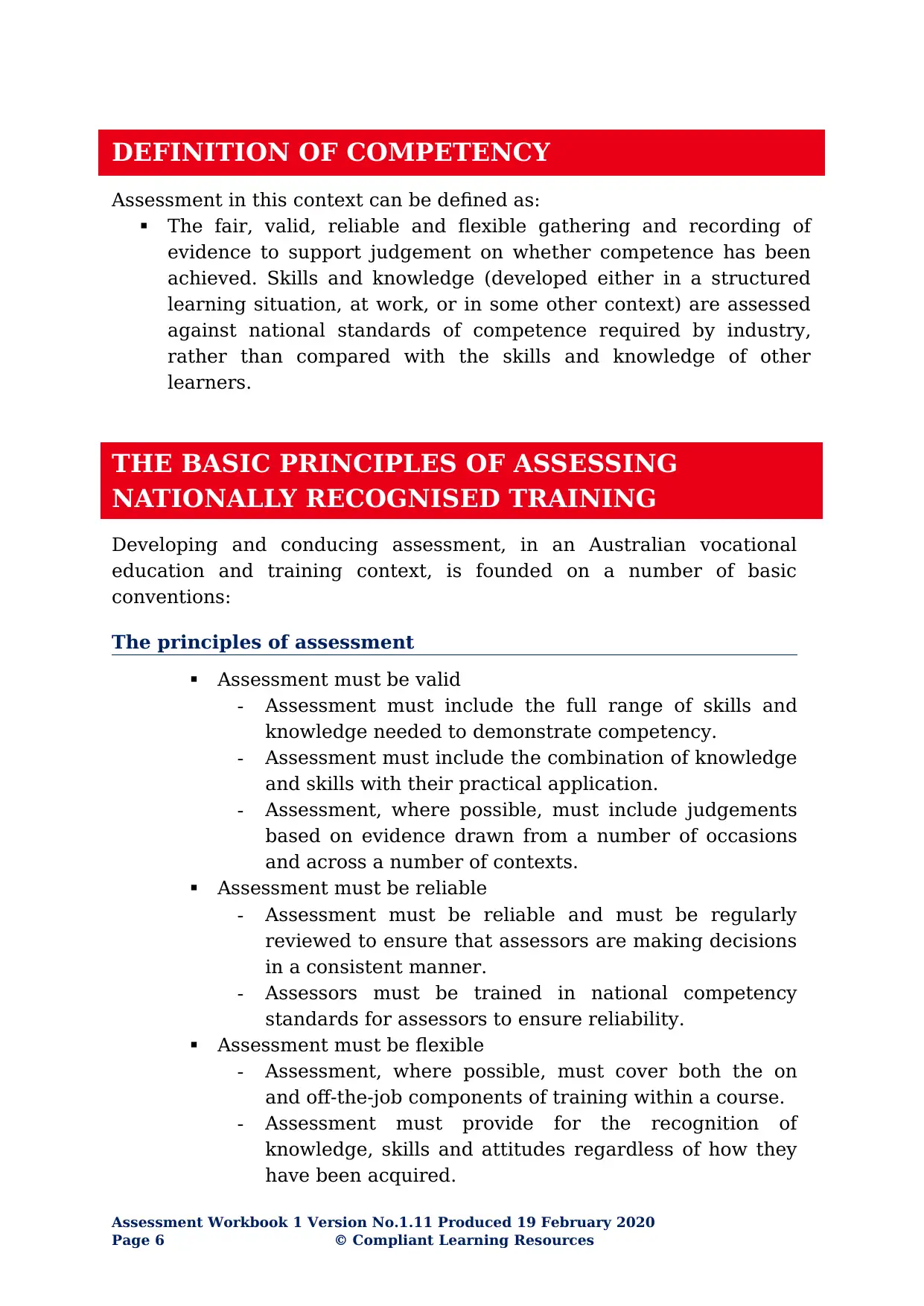
DEFINITION OF COMPETENCY
Assessment in this context can be defined as:
The fair, valid, reliable and flexible gathering and recording of
evidence to support judgement on whether competence has been
achieved. Skills and knowledge (developed either in a structured
learning situation, at work, or in some other context) are assessed
against national standards of competence required by industry,
rather than compared with the skills and knowledge of other
learners.
THE BASIC PRINCIPLES OF ASSESSING
NATIONALLY RECOGNISED TRAINING
Developing and conducing assessment, in an Australian vocational
education and training context, is founded on a number of basic
conventions:
The principles of assessment
Assessment must be valid
- Assessment must include the full range of skills and
knowledge needed to demonstrate competency.
- Assessment must include the combination of knowledge
and skills with their practical application.
- Assessment, where possible, must include judgements
based on evidence drawn from a number of occasions
and across a number of contexts.
Assessment must be reliable
- Assessment must be reliable and must be regularly
reviewed to ensure that assessors are making decisions
in a consistent manner.
- Assessors must be trained in national competency
standards for assessors to ensure reliability.
Assessment must be flexible
- Assessment, where possible, must cover both the on
and off-the-job components of training within a course.
- Assessment must provide for the recognition of
knowledge, skills and attitudes regardless of how they
have been acquired.
Assessment Workbook 1 Version No.1.11 Produced 19 February 2020
Page 6 © Compliant Learning Resources
Assessment in this context can be defined as:
The fair, valid, reliable and flexible gathering and recording of
evidence to support judgement on whether competence has been
achieved. Skills and knowledge (developed either in a structured
learning situation, at work, or in some other context) are assessed
against national standards of competence required by industry,
rather than compared with the skills and knowledge of other
learners.
THE BASIC PRINCIPLES OF ASSESSING
NATIONALLY RECOGNISED TRAINING
Developing and conducing assessment, in an Australian vocational
education and training context, is founded on a number of basic
conventions:
The principles of assessment
Assessment must be valid
- Assessment must include the full range of skills and
knowledge needed to demonstrate competency.
- Assessment must include the combination of knowledge
and skills with their practical application.
- Assessment, where possible, must include judgements
based on evidence drawn from a number of occasions
and across a number of contexts.
Assessment must be reliable
- Assessment must be reliable and must be regularly
reviewed to ensure that assessors are making decisions
in a consistent manner.
- Assessors must be trained in national competency
standards for assessors to ensure reliability.
Assessment must be flexible
- Assessment, where possible, must cover both the on
and off-the-job components of training within a course.
- Assessment must provide for the recognition of
knowledge, skills and attitudes regardless of how they
have been acquired.
Assessment Workbook 1 Version No.1.11 Produced 19 February 2020
Page 6 © Compliant Learning Resources
⊘ This is a preview!⊘
Do you want full access?
Subscribe today to unlock all pages.

Trusted by 1+ million students worldwide
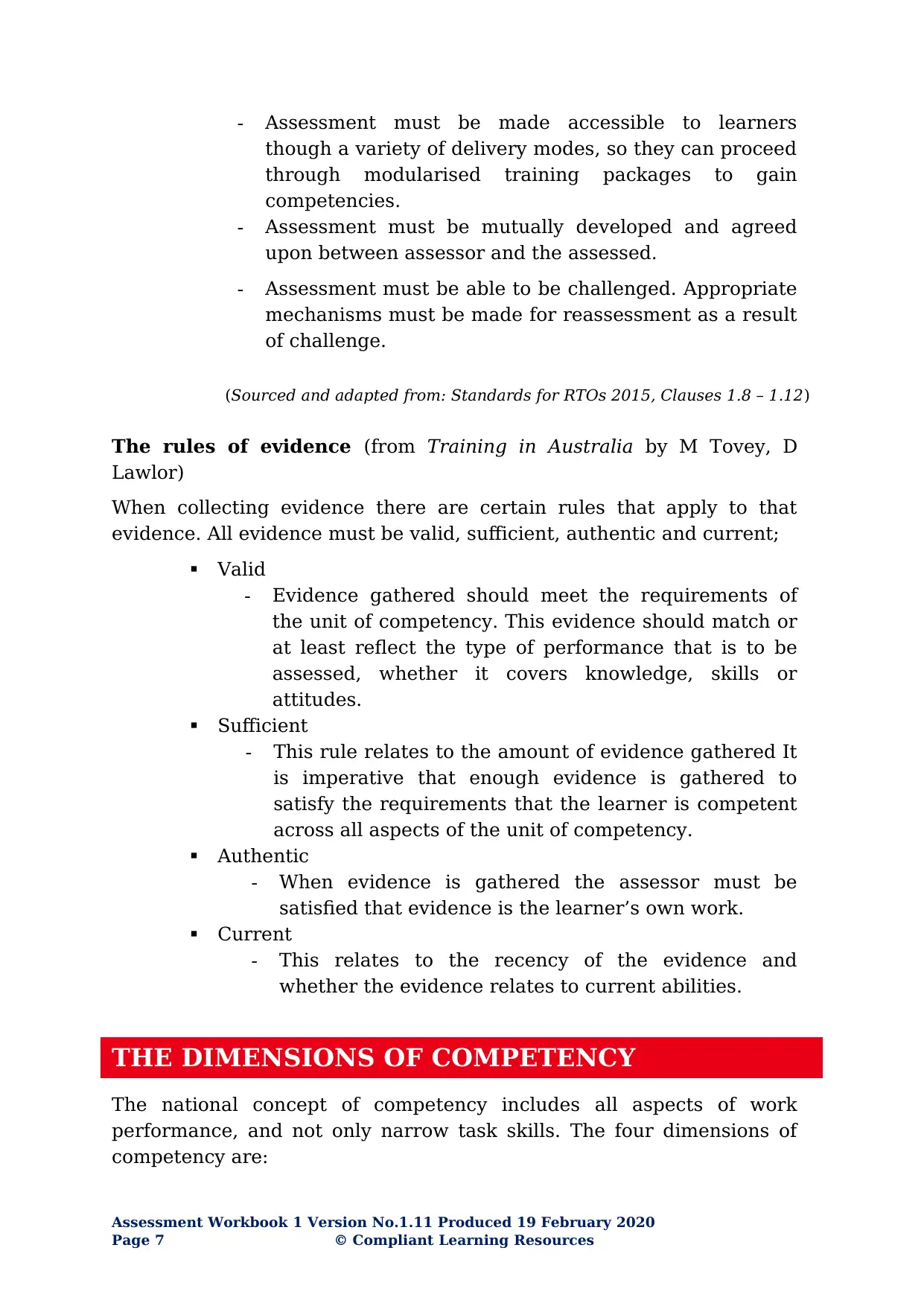
- Assessment must be made accessible to learners
though a variety of delivery modes, so they can proceed
through modularised training packages to gain
competencies.
- Assessment must be mutually developed and agreed
upon between assessor and the assessed.
- Assessment must be able to be challenged. Appropriate
mechanisms must be made for reassessment as a result
of challenge.
(Sourced and adapted from: Standards for RTOs 2015, Clauses 1.8 – 1.12)
The rules of evidence (from Training in Australia by M Tovey, D
Lawlor)
When collecting evidence there are certain rules that apply to that
evidence. All evidence must be valid, sufficient, authentic and current;
Valid
- Evidence gathered should meet the requirements of
the unit of competency. This evidence should match or
at least reflect the type of performance that is to be
assessed, whether it covers knowledge, skills or
attitudes.
Sufficient
- This rule relates to the amount of evidence gathered It
is imperative that enough evidence is gathered to
satisfy the requirements that the learner is competent
across all aspects of the unit of competency.
Authentic
- When evidence is gathered the assessor must be
satisfied that evidence is the learner’s own work.
Current
- This relates to the recency of the evidence and
whether the evidence relates to current abilities.
THE DIMENSIONS OF COMPETENCY
The national concept of competency includes all aspects of work
performance, and not only narrow task skills. The four dimensions of
competency are:
Assessment Workbook 1 Version No.1.11 Produced 19 February 2020
Page 7 © Compliant Learning Resources
though a variety of delivery modes, so they can proceed
through modularised training packages to gain
competencies.
- Assessment must be mutually developed and agreed
upon between assessor and the assessed.
- Assessment must be able to be challenged. Appropriate
mechanisms must be made for reassessment as a result
of challenge.
(Sourced and adapted from: Standards for RTOs 2015, Clauses 1.8 – 1.12)
The rules of evidence (from Training in Australia by M Tovey, D
Lawlor)
When collecting evidence there are certain rules that apply to that
evidence. All evidence must be valid, sufficient, authentic and current;
Valid
- Evidence gathered should meet the requirements of
the unit of competency. This evidence should match or
at least reflect the type of performance that is to be
assessed, whether it covers knowledge, skills or
attitudes.
Sufficient
- This rule relates to the amount of evidence gathered It
is imperative that enough evidence is gathered to
satisfy the requirements that the learner is competent
across all aspects of the unit of competency.
Authentic
- When evidence is gathered the assessor must be
satisfied that evidence is the learner’s own work.
Current
- This relates to the recency of the evidence and
whether the evidence relates to current abilities.
THE DIMENSIONS OF COMPETENCY
The national concept of competency includes all aspects of work
performance, and not only narrow task skills. The four dimensions of
competency are:
Assessment Workbook 1 Version No.1.11 Produced 19 February 2020
Page 7 © Compliant Learning Resources
Paraphrase This Document
Need a fresh take? Get an instant paraphrase of this document with our AI Paraphraser
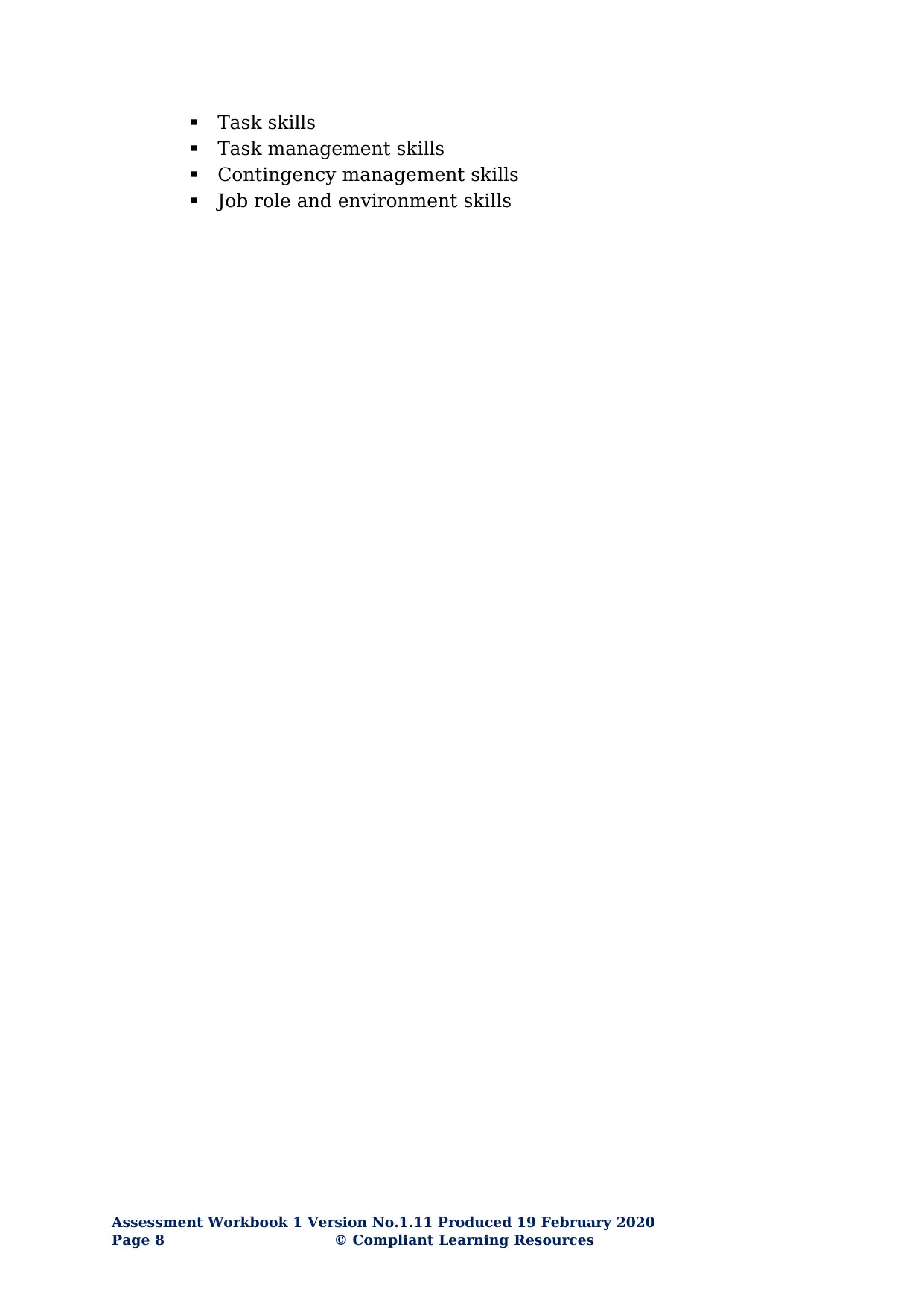
Task skills
Task management skills
Contingency management skills
Job role and environment skills
Assessment Workbook 1 Version No.1.11 Produced 19 February 2020
Page 8 © Compliant Learning Resources
Task management skills
Contingency management skills
Job role and environment skills
Assessment Workbook 1 Version No.1.11 Produced 19 February 2020
Page 8 © Compliant Learning Resources
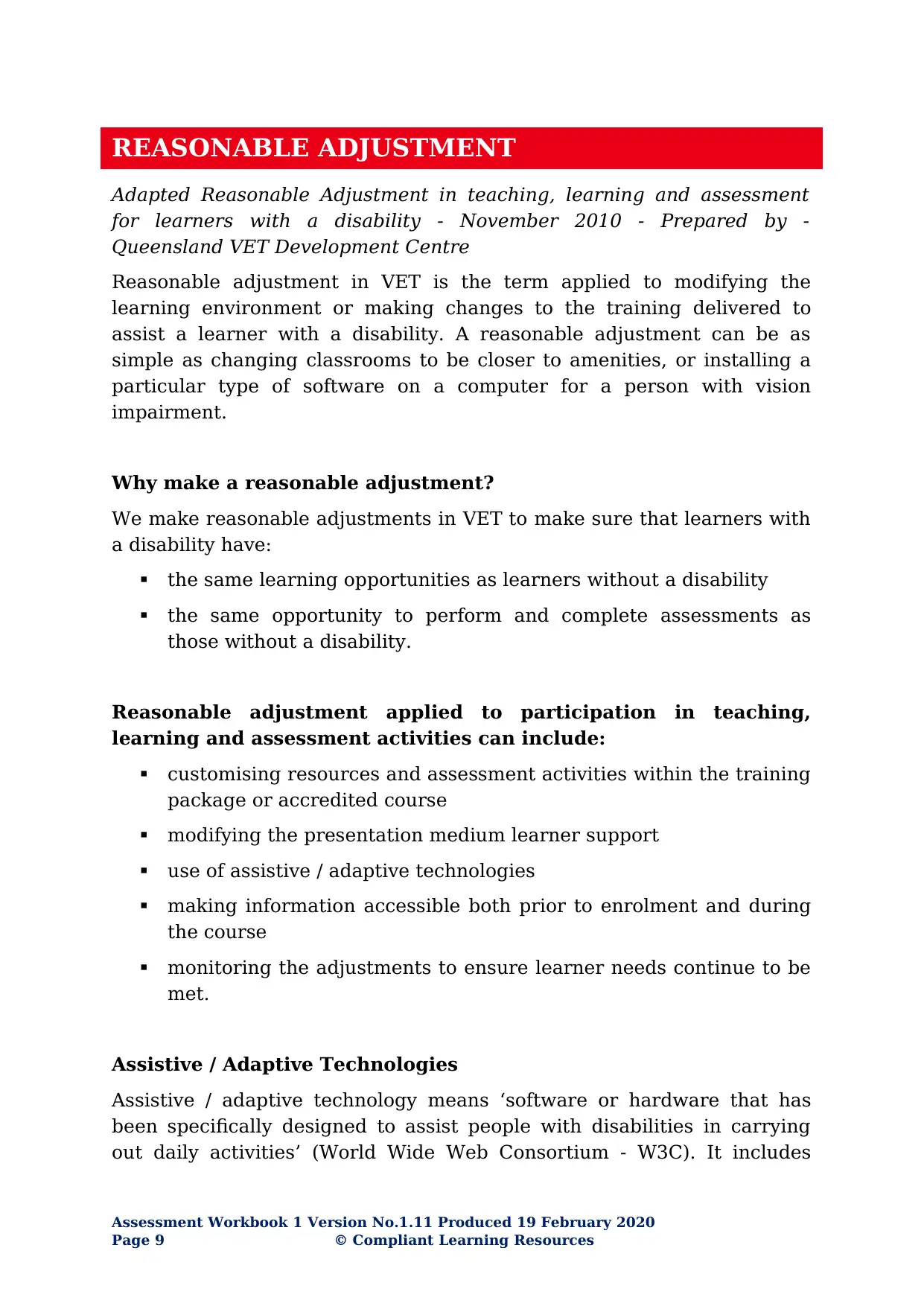
REASONABLE ADJUSTMENT
Adapted Reasonable Adjustment in teaching, learning and assessment
for learners with a disability - November 2010 - Prepared by -
Queensland VET Development Centre
Reasonable adjustment in VET is the term applied to modifying the
learning environment or making changes to the training delivered to
assist a learner with a disability. A reasonable adjustment can be as
simple as changing classrooms to be closer to amenities, or installing a
particular type of software on a computer for a person with vision
impairment.
Why make a reasonable adjustment?
We make reasonable adjustments in VET to make sure that learners with
a disability have:
the same learning opportunities as learners without a disability
the same opportunity to perform and complete assessments as
those without a disability.
Reasonable adjustment applied to participation in teaching,
learning and assessment activities can include:
customising resources and assessment activities within the training
package or accredited course
modifying the presentation medium learner support
use of assistive / adaptive technologies
making information accessible both prior to enrolment and during
the course
monitoring the adjustments to ensure learner needs continue to be
met.
Assistive / Adaptive Technologies
Assistive / adaptive technology means ‘software or hardware that has
been specifically designed to assist people with disabilities in carrying
out daily activities’ (World Wide Web Consortium - W3C). It includes
Assessment Workbook 1 Version No.1.11 Produced 19 February 2020
Page 9 © Compliant Learning Resources
Adapted Reasonable Adjustment in teaching, learning and assessment
for learners with a disability - November 2010 - Prepared by -
Queensland VET Development Centre
Reasonable adjustment in VET is the term applied to modifying the
learning environment or making changes to the training delivered to
assist a learner with a disability. A reasonable adjustment can be as
simple as changing classrooms to be closer to amenities, or installing a
particular type of software on a computer for a person with vision
impairment.
Why make a reasonable adjustment?
We make reasonable adjustments in VET to make sure that learners with
a disability have:
the same learning opportunities as learners without a disability
the same opportunity to perform and complete assessments as
those without a disability.
Reasonable adjustment applied to participation in teaching,
learning and assessment activities can include:
customising resources and assessment activities within the training
package or accredited course
modifying the presentation medium learner support
use of assistive / adaptive technologies
making information accessible both prior to enrolment and during
the course
monitoring the adjustments to ensure learner needs continue to be
met.
Assistive / Adaptive Technologies
Assistive / adaptive technology means ‘software or hardware that has
been specifically designed to assist people with disabilities in carrying
out daily activities’ (World Wide Web Consortium - W3C). It includes
Assessment Workbook 1 Version No.1.11 Produced 19 February 2020
Page 9 © Compliant Learning Resources
⊘ This is a preview!⊘
Do you want full access?
Subscribe today to unlock all pages.

Trusted by 1+ million students worldwide
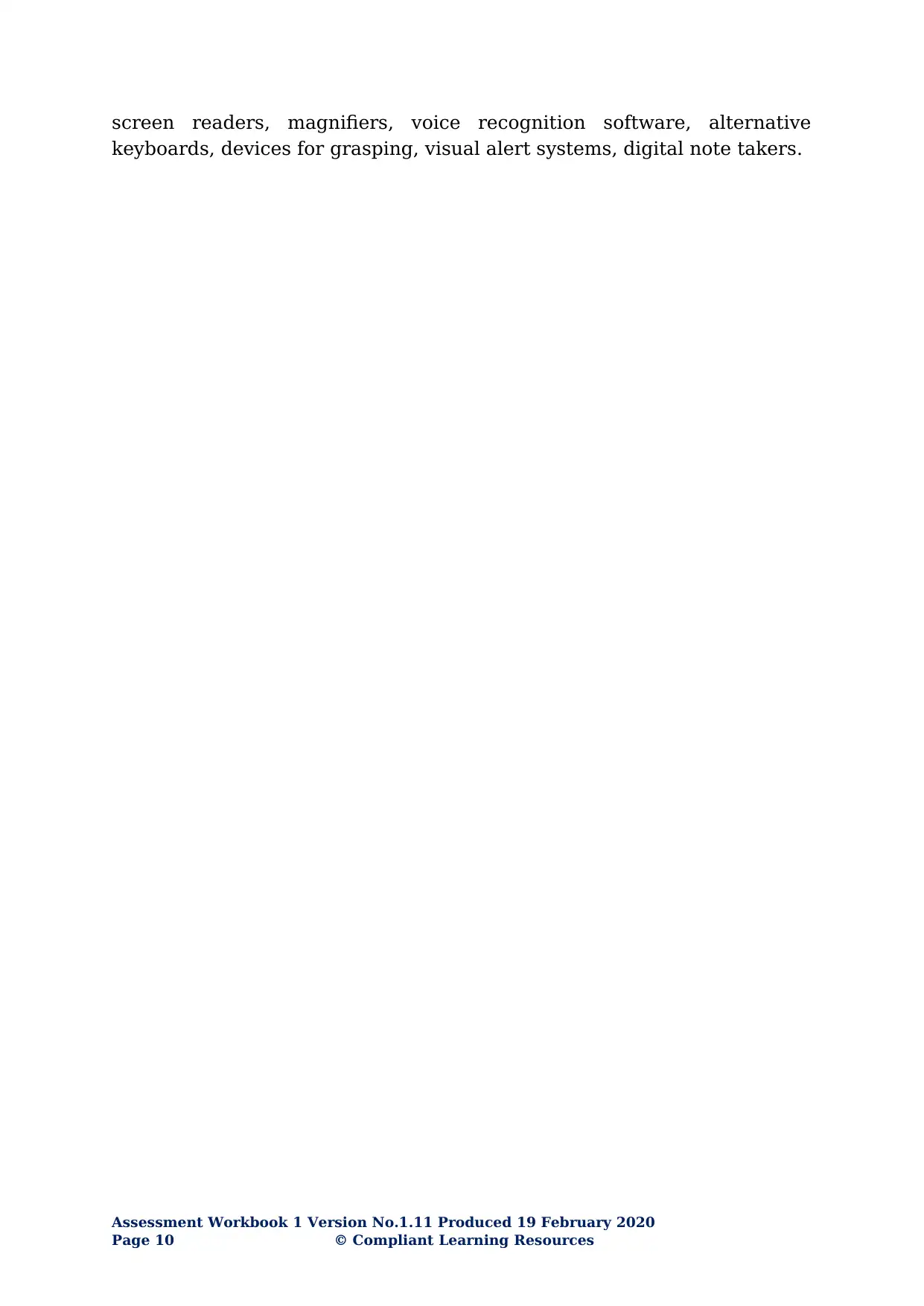
screen readers, magnifiers, voice recognition software, alternative
keyboards, devices for grasping, visual alert systems, digital note takers.
Assessment Workbook 1 Version No.1.11 Produced 19 February 2020
Page 10 © Compliant Learning Resources
keyboards, devices for grasping, visual alert systems, digital note takers.
Assessment Workbook 1 Version No.1.11 Produced 19 February 2020
Page 10 © Compliant Learning Resources
Paraphrase This Document
Need a fresh take? Get an instant paraphrase of this document with our AI Paraphraser
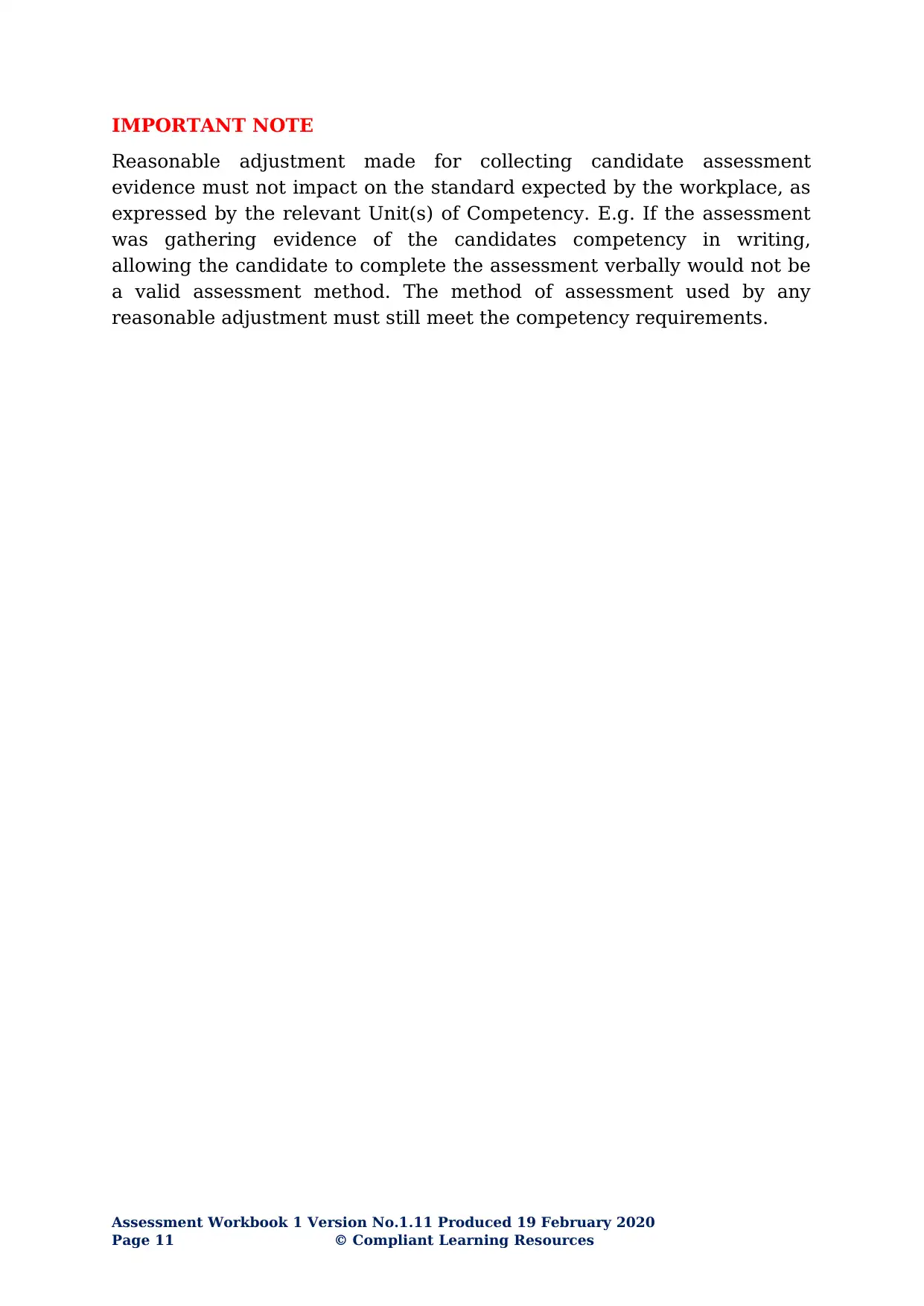
IMPORTANT NOTE
Reasonable adjustment made for collecting candidate assessment
evidence must not impact on the standard expected by the workplace, as
expressed by the relevant Unit(s) of Competency. E.g. If the assessment
was gathering evidence of the candidates competency in writing,
allowing the candidate to complete the assessment verbally would not be
a valid assessment method. The method of assessment used by any
reasonable adjustment must still meet the competency requirements.
Assessment Workbook 1 Version No.1.11 Produced 19 February 2020
Page 11 © Compliant Learning Resources
Reasonable adjustment made for collecting candidate assessment
evidence must not impact on the standard expected by the workplace, as
expressed by the relevant Unit(s) of Competency. E.g. If the assessment
was gathering evidence of the candidates competency in writing,
allowing the candidate to complete the assessment verbally would not be
a valid assessment method. The method of assessment used by any
reasonable adjustment must still meet the competency requirements.
Assessment Workbook 1 Version No.1.11 Produced 19 February 2020
Page 11 © Compliant Learning Resources
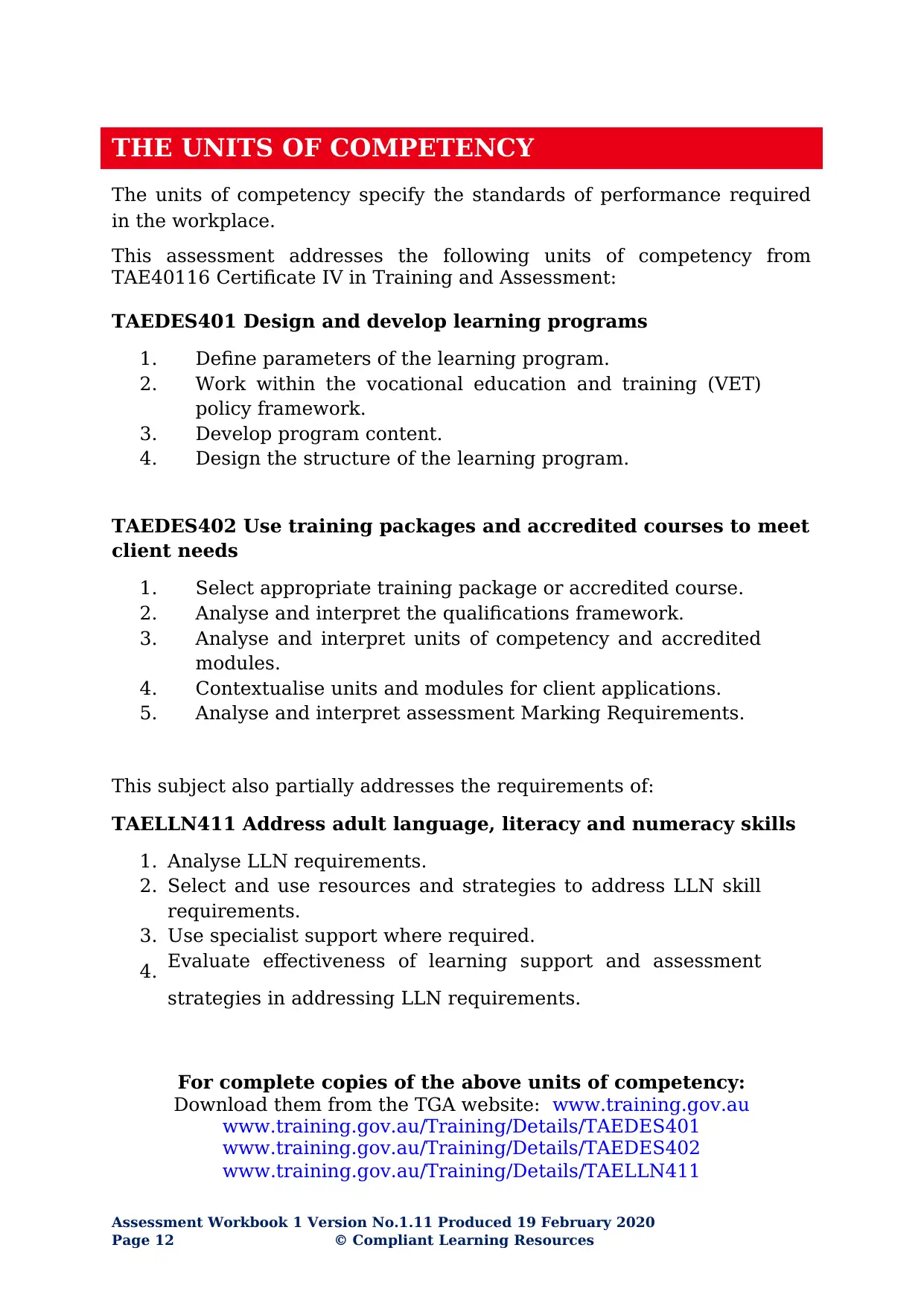
THE UNITS OF COMPETENCY
The units of competency specify the standards of performance required
in the workplace.
This assessment addresses the following units of competency from
TAE40116 Certificate IV in Training and Assessment:
TAEDES401 Design and develop learning programs
1. Define parameters of the learning program.
2. Work within the vocational education and training (VET)
policy framework.
3. Develop program content.
4. Design the structure of the learning program.
TAEDES402 Use training packages and accredited courses to meet
client needs
1. Select appropriate training package or accredited course.
2. Analyse and interpret the qualifications framework.
3. Analyse and interpret units of competency and accredited
modules.
4. Contextualise units and modules for client applications.
5. Analyse and interpret assessment Marking Requirements.
This subject also partially addresses the requirements of:
TAELLN411 Address adult language, literacy and numeracy skills
1. Analyse LLN requirements.
2. Select and use resources and strategies to address LLN skill
requirements.
3. Use specialist support where required.
4. Evaluate effectiveness of learning support and assessment
strategies in addressing LLN requirements.
For complete copies of the above units of competency:
Download them from the TGA website: www.training.gov.au
www.training.gov.au/Training/Details/TAEDES401
www.training.gov.au/Training/Details/TAEDES402
www.training.gov.au/Training/Details/TAELLN411
Assessment Workbook 1 Version No.1.11 Produced 19 February 2020
Page 12 © Compliant Learning Resources
The units of competency specify the standards of performance required
in the workplace.
This assessment addresses the following units of competency from
TAE40116 Certificate IV in Training and Assessment:
TAEDES401 Design and develop learning programs
1. Define parameters of the learning program.
2. Work within the vocational education and training (VET)
policy framework.
3. Develop program content.
4. Design the structure of the learning program.
TAEDES402 Use training packages and accredited courses to meet
client needs
1. Select appropriate training package or accredited course.
2. Analyse and interpret the qualifications framework.
3. Analyse and interpret units of competency and accredited
modules.
4. Contextualise units and modules for client applications.
5. Analyse and interpret assessment Marking Requirements.
This subject also partially addresses the requirements of:
TAELLN411 Address adult language, literacy and numeracy skills
1. Analyse LLN requirements.
2. Select and use resources and strategies to address LLN skill
requirements.
3. Use specialist support where required.
4. Evaluate effectiveness of learning support and assessment
strategies in addressing LLN requirements.
For complete copies of the above units of competency:
Download them from the TGA website: www.training.gov.au
www.training.gov.au/Training/Details/TAEDES401
www.training.gov.au/Training/Details/TAEDES402
www.training.gov.au/Training/Details/TAELLN411
Assessment Workbook 1 Version No.1.11 Produced 19 February 2020
Page 12 © Compliant Learning Resources
⊘ This is a preview!⊘
Do you want full access?
Subscribe today to unlock all pages.

Trusted by 1+ million students worldwide
1 out of 129
Related Documents
Your All-in-One AI-Powered Toolkit for Academic Success.
+13062052269
info@desklib.com
Available 24*7 on WhatsApp / Email
![[object Object]](/_next/static/media/star-bottom.7253800d.svg)
Unlock your academic potential
Copyright © 2020–2025 A2Z Services. All Rights Reserved. Developed and managed by ZUCOL.





